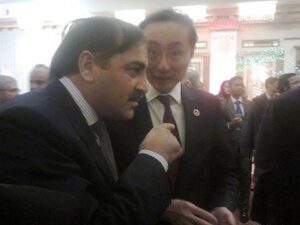By Qamar Bashir
At the 2025 IISS Shangri-La Dialogue, U.S. Secretary of Defense Pete Hegseth stood
before a packed hall and delivered a speech on behalf of Donald Trump that was as much
a confession as it was a call to arms. At the outset, Hegseth candidly admitted that the
U.S. Army and Defense Forces have lost their luster. Their capability, he declared, is
incompatible with the current global security landscape, and the entire system demands a
complete overhaul. The U.S. military outlook is bleak, far short of what is required to
counter the pressing and growing threats facing the nation. In a stark and unflinching
tone, he outlined three imminent threats—not only to the United States, but also to the
Indo-Pacific region and all nations allied with the U.S.
After exposing the glaring shortcomings in America’s military readiness, Hegseth
pledged to lead the charge in rebuilding U.S. military might—restoring it to a dominant
force capable of global projection and, in his words, restoring the “lethal prowness” that
once defined American military supremacy. But in doing so, he made it clear that this
burden would not fall on the U.S. alone. Hegseth openly called on America’s allies to
share the cost of this military buildup. He pointed to Europe, where defense spending has
already risen to 5% of GDP in several NATO nations, and called on Indo-Pacific partners
to match this commitment—urging them to raise their own military spending to 5% of
GDP.
This, however, is not merely about defending collective interests. By constructing a
narrative of existential threat—painting China, North Korea, and Iran as the axis of
global instability—Hegseth is laying the groundwork for an aggressive American
defense-industrial push. His call for increased defense spending is, in effect, a veiled
strategy to sell U.S. military hardware, expertise, and services to allies—transforming the
American defense sector into an engine of economic growth while pushing allies into
deeper military dependence.
Hegseth’s narrative was clear: China is the primary threat, followed by North Korea’s
nuclear ambitions and Iran’s pursuit of nuclear capabilities. He made a categorical
statement: Iran will never be allowed to develop a nuclear weapon—an assertion that
highlights the double standard of a global order where the U.S., Israel, India, and Europe
reserve the right to develop any weapons they choose, while others are denied the same
sovereignty.
First and foremost, Hegseth emphasized the unprecedented growth of China’s war
capabilities, achieved while the U.S. slept at the wheel. China’s advancements in cyber
technology, airpower, and shipbuilding have been nothing short of remarkable. The scale
and speed of China’s military build-up—measured in hypersonic missile tests, artificial
intelligence integration, and a fleet of over 350 naval ships, including aircraft carriers and
stealth destroyers—have raised alarm bells across the Indo-Pacific. Hegseth bluntly
warned China not to use this military might to intimidate its neighbors—Taiwan, the
Philippines, Australia, and others in the region.
Yet, Hegseth’s attempt to portray India as a rising counterweight to China rang hollow.
He highlighted the U.S.-India defense cooperation as a model, citing joint military
exercises and technology sharing. But the recent humiliating performance of India’s
military—against a far smaller, resource-constrained Pakistan, grappling with economic
and political crises—drew quiet laughter from the audience. Many delegates questioned
how India, unable to stand up to Pakistan, could possibly challenge China. It was a
moment that underscored the futility of propping up India as a strategic equal to China;
India, as Hegseth’s own narrative inadvertently exposed, is years—if not decades—away
from posing any meaningful military challenge to Beijing.
While the U.S. is scrambling to revive its military-industrial complex, China has charted
a different course—one rooted not in military aggression, but in strategic patience,
economic integration, and a long-term vision for global engagement. Historically, China
has never pursued colonization; even the Great Wall was a defensive measure, not a
springboard for conquest. Today, China is building a new kind of “Great Wall”—a
deterrence strategy based on formidable military capabilities, yes, but also on economic
connectivity, infrastructure development, and partnerships that create win-win scenarios
globally.
China’s Belt and Road Initiative spans over 150 countries, building ports, roads, railways,
and digital infrastructure. While the U.S. urges its allies to cut economic ties with China
and instead buy American weapons, China is quietly creating interdependencies that
promote peace, stability, and shared prosperity. Chinese projects in Africa, Central Asia,
and the Pacific are not merely about profit; they are about creating an environment where
countries are economically entangled in a way that makes conflict undesirable.
Hegseth’s call to decouple economically from China is a direct admission of
Washington’s fear: that economic interdependence makes military adventurism risky and
costly. By urging allies to sever economic ties with China, he hopes to create a
geopolitical environment where military options become viable again. But this strategy is
inherently flawed. Allies are not blind. They understand that buying American weapons
comes at the cost of their own economic growth. It does not create jobs, build ports, or
feed their people. It simply arms them for wars they may not want to fight.
Hegseth’s vision, in essence, is a return to the old Cold War playbook—framing China as
a “communist threat,” invoking ideological rhetoric that has little resonance in today’s
multipolar world. It’s a narrative that ignores the fact that China’s system, while single-
party, has lifted over 800 million people out of poverty, created the world’s largest
middle class, and is now extending prosperity to partner nations worldwide.
The stark contrast between America’s approach and China’s could not be clearer. While
the U.S. builds walls of militarization, China builds bridges of trade. While the U.S. sells
fear, China offers infrastructure. While the U.S. warns of threats, China promotes mutual
benefit. The U.S. narrative is built on a crumbling foundation of outdated military
dominance, while China’s strategy is grounded in economic diplomacy, technological
innovation, and a steadfast commitment to non-interference.
Hegseth’s Shangri-La speech may have been a rallying cry for America’s military-
industrial complex, but it also laid bare the limitations of the U.S. approach. Until the
U.S. pivots from war-mongering to economic cooperation, from selling weapons to
building infrastructure, it will struggle to counter China’s rising influence. The world is
watching, and the choice is stark: a future of arms races and conflict, or one of shared
prosperity and peace. The path forward is clear, but it requires the U.S. to shed its old
habits—and that is a lesson yet to be learned.
-Writer is Press Secretary to the President (Rtd)
Former Press Minister at the Embassy of Pakistan to France
Former MD, SRBC
Macomb, Michigan, USA




